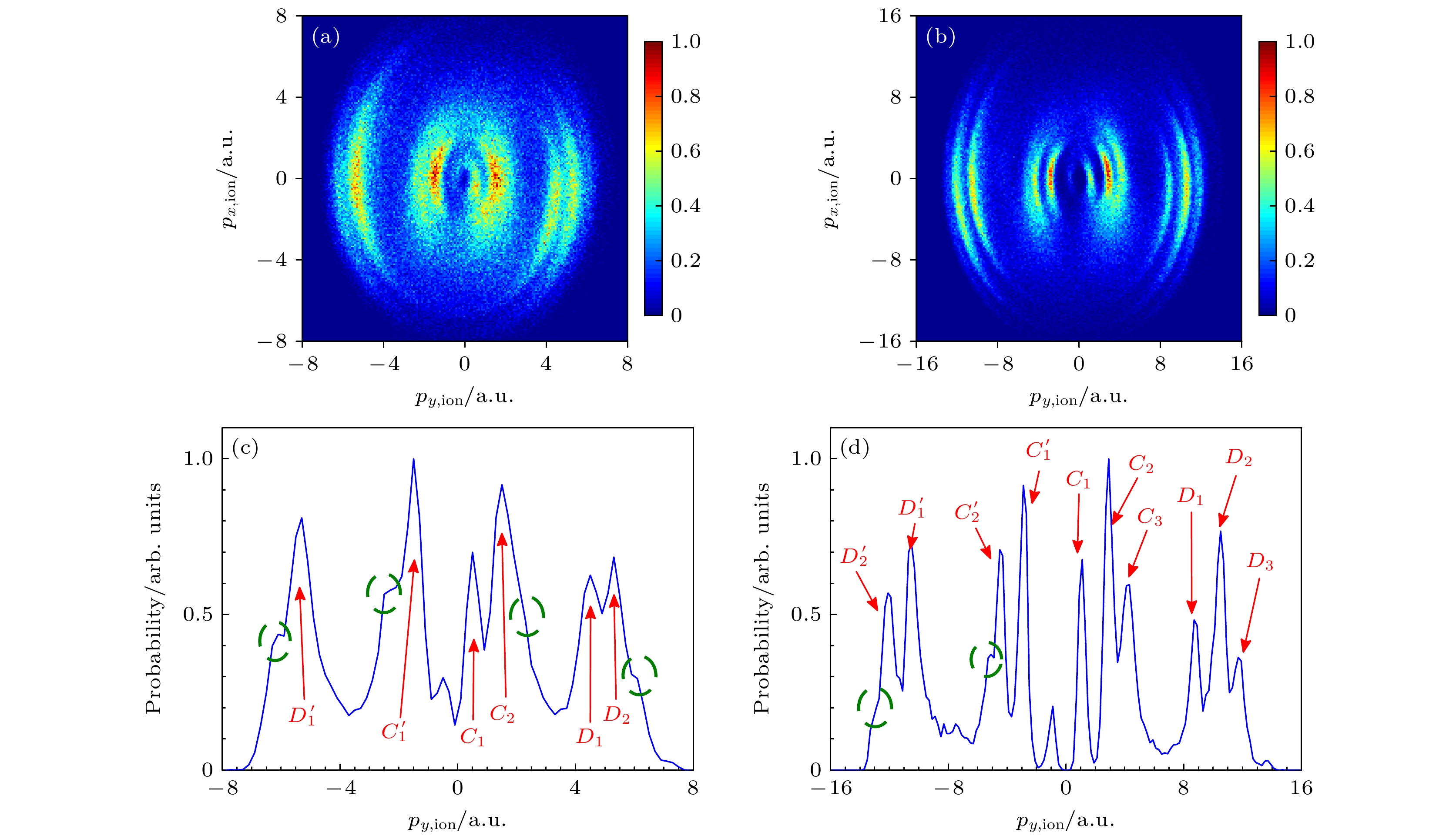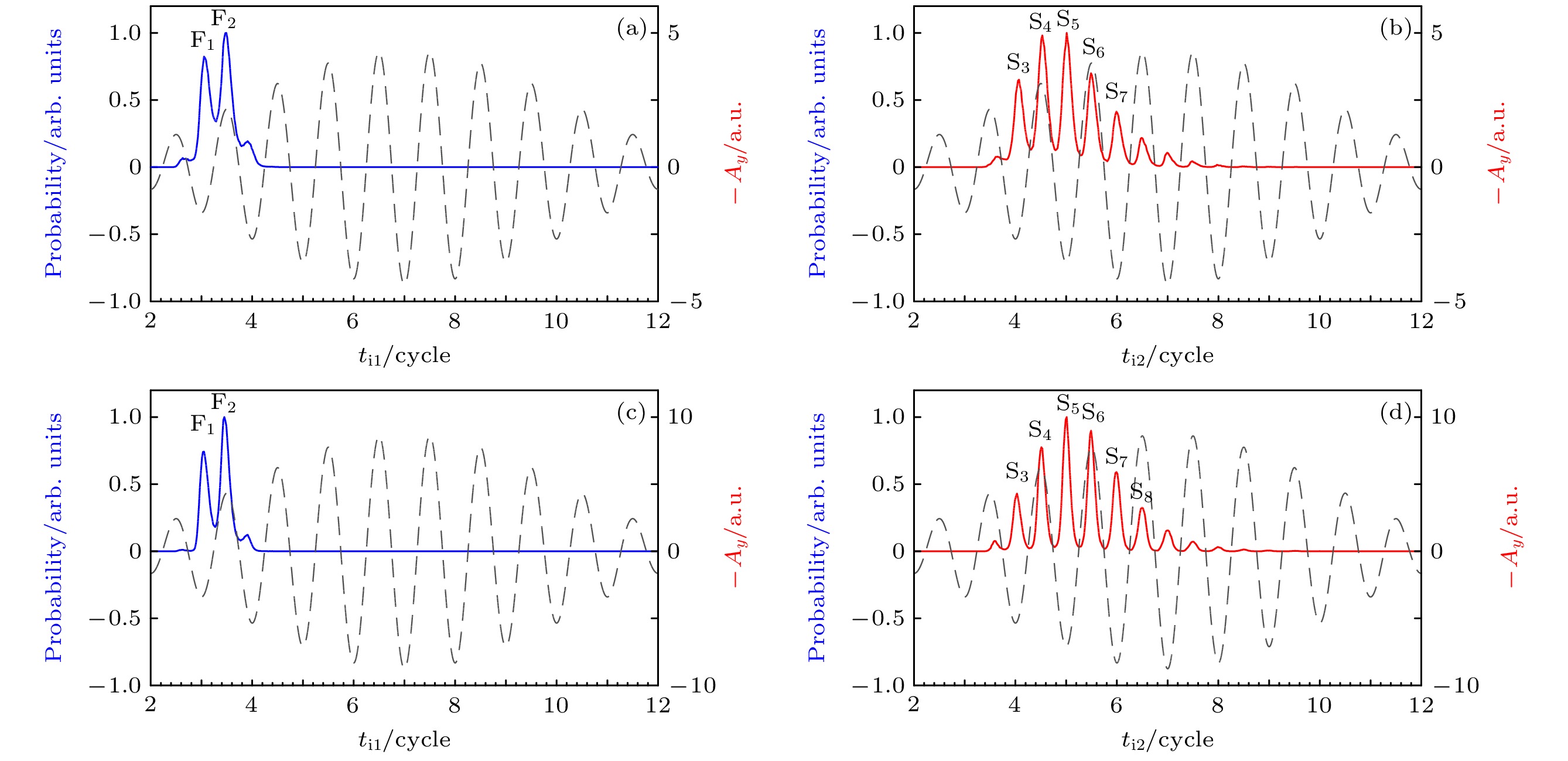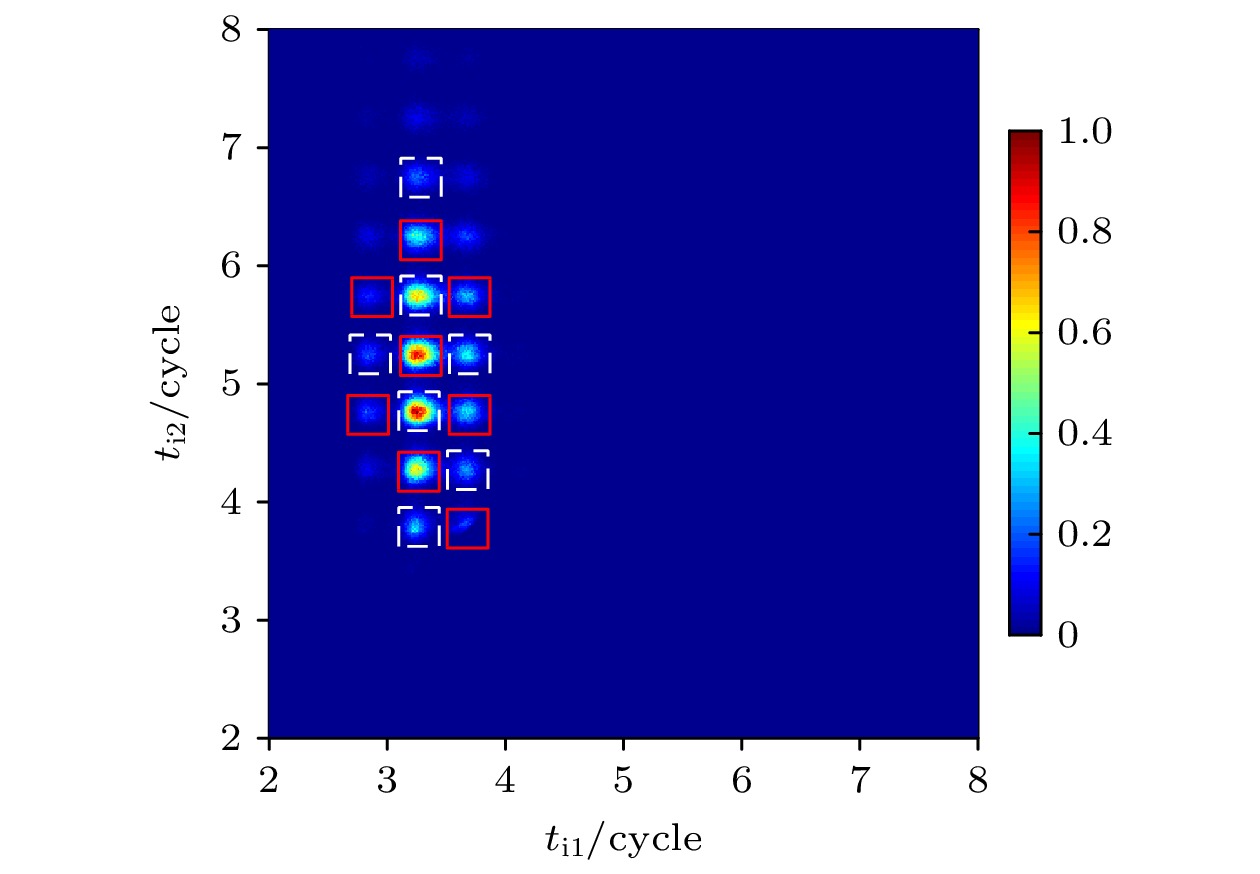-
In this paper, we utilize a classical ensemble model with Heisenberg-core potential to study sequential double ionization (SDI) of Ar atom by an elliptically polarized laser field. The results show that for random laser phases, as the laser wavelength increases, the ion momentum distribution gradually evolves from a six-band structure at 800 nm to an eight-band structure at 1600 nm. When the laser phase is stable, the ion momentum distribution from 1600 nm laser field exhibits a ten-band structure. These multi-band structures directly reflect the subcycle ionization dynamics of electrons in an elliptically polarized laser field. There is a significant shift among the outer three bands of ion momentum distrbutions from different laser phases, which leads to the fact that only one band is observed in the outer region of the ion momentum distribution for the case of random laser phases. By analyzing the ionization times of the two electrons, it is found that for the case of random phases, the inner bands of the ion momentum distributions originate from those combinations of electron ionization bursts with the ionization time difference of 0.5 cycle, and the outer bands arise from those combinations of ionization bursts with the ionization time difference of 1, 2 and 3 cycles. For 800 nm, the middle band corresponds to those combinations of ionization bursts with the ionization time differences of 1.5 and 2.5 cycles. For 1600 nm, there are two bands in middle regime. One is from the combination with the ionization time difference of 1.5 cycles, and the other is from those combinations with the ionization time difference of 2.5 and 3.5 cycles. These results indicate that in the case of long wavelength and phase-stable laser, the subcycle dynamics in sequential double ionization of atoms is more likely to be observed.
-
Keywords:
- elliptically polarized fields /
- sequential double ionization /
- ion momentum distribution /
- subcycle dynamics
[1] L’ Huillier A, Lompre L A, Mainfray G, Manus C 1982 Phys. Rev. Lett. 48 1814
 Google Scholar
Google Scholar
[2] Wang Y L, Xu S P, Quan W, Gong C, Lai X Y, Hu S L, Liu M Q, Chen J, Liu X J 2016 Phys. Rev. A 94 053412
 Google Scholar
Google Scholar
[3] Liu Y Q, Fu L B, Ye D F, Liu J, Li M, Wu C Y, Gong Q H, Moshammer R, Ullrich J 2014 Phys. Rev. Lett. 112 013003
 Google Scholar
Google Scholar
[4] Ye D F, Li M, Fu L B, Liu J, Gong Q H, Liu Y Q, Ullrich J 2015 Phys. Rev. Lett. 115 123001
 Google Scholar
Google Scholar
[5] Lin K, Jia X Y, Yu Z Q, He F, Ma J Y, Li H, Gong X C, Song Q Y, Ji Q Y, Zhang W B, Li H X, Lu P F, Zeng H P, Chen J, Wu J 2017 Phys. Rev. Lett. 119 203202
 Google Scholar
Google Scholar
[6] Liao Q, Winney A H, Lee S K, Lin Y F, Adhikari P, Li W 2017 Phys. Rev. A 96 023401
 Google Scholar
Google Scholar
[7] Hao X L, Chen J, Li W D, Wang B B, Wang X D, Becker W 2014 Phys. Rev. Lett. 112 073002
 Google Scholar
Google Scholar
[8] Chen Z J, Liang Y Q, Lin C D 2010 Phys. Rev. Lett. 104 253201
 Google Scholar
Google Scholar
[9] Li B Q, Yang X, Ren X H, Zhang J T 2019 Opt. Express 27 32700
 Google Scholar
Google Scholar
[10] Maharjan C M, Alnaser A S, Tong X M, Ulrich B, Ranitovic P, Ghimire S, Chang Z, Litvinyuk I V, Cocke C L 2005 Phys. Rev. A 72 041403
 Google Scholar
Google Scholar
[11] Wang X, Eberly J H 2009 Phys. Rev. Lett. 103 103007
 Google Scholar
Google Scholar
[12] Pfeiffer A N, Cirelli C, Smolarski M, Döner R, Keller U 2011 Nature Phys. 7 428
 Google Scholar
Google Scholar
[13] Pfeiffer A N, Cirelli C, Smolarski M, Wang X, Eberly J H, Döner R, Keller U 2011 New J. Phys. 13 093008
 Google Scholar
Google Scholar
[14] Zhou Y M, Huang C, Liao Q, Lu P X 2012 Phys. Rev. Lett. 109 053004
 Google Scholar
Google Scholar
[15] Zhou Y M, Zhang Q B, Huang C, Lu P X 2012 Phys. Rev. A 86 043427
 Google Scholar
Google Scholar
[16] Wang X, Eberly J H 2011 arXiv: 1102.0221v1 [physics. atom-ph
[17] Zhou Y M, Li M, Li Y, Tong A H, Li Q G, Lu P X 2017 Opt. Express 25 8450
 Google Scholar
Google Scholar
[18] Tong A H, Zhou Y M, Lu P X 2015 Opt. Express 23 15774
 Google Scholar
Google Scholar
[19] Schöffler M S, Xie X, Wustelt P, Moller M, Roither S, Kartashov D, Sayler A M, Baltuska A, Paulus G G, Kitzler M 2016 Phys. Rev. A 93 063421
 Google Scholar
Google Scholar
[20] Parker J S, Doherty B J S, Taylor K T, Schultz K D, Blaga C I, DiMauro L F 2006 Phys. Rev. Lett. 96 133001
 Google Scholar
Google Scholar
[21] Chen J, Liu J, Fu L B, Zheng W M 2000 Phys. Rev. A 63 011404(R
 Google Scholar
Google Scholar
[22] Haan S L, Breen L, Karim A, Eberly J H 2006 Phys. Rev. Lett. 97 103008
 Google Scholar
Google Scholar
[23] Su J, Liu Z C, Liao J Y, Huang X F, Li Y B, Huang C 2022 Opt. Express 30 24898
 Google Scholar
Google Scholar
[24] Xu T T, Zhu Q Y, Chen J H, Ben S, Zhang J, Liu X S 2018 Opt. Express 26 1645
 Google Scholar
Google Scholar
[25] Li Y B, Yu B H, Tang Q B, Wang X, Hua D Y, Tong A H, Jiang C H, Ge G X, Li Y C, Wan J G 2016 Opt. Express 24 6469
 Google Scholar
Google Scholar
[26] 苏杰, 刘子超, 廖健颖, 李盈傧, 黄诚 2022 物理学报 71 193201
 Google Scholar
Google Scholar
Su J, Liu Z C, Liao J Y, Li Y B, Huang C 2022 Acta Phys. Sin. 71 193201
 Google Scholar
Google Scholar
[27] Wilets L, Henley E M, Kraft M, Mackellar A D 1977 Nucl. Phys. A 282 341
 Google Scholar
Google Scholar
[28] Kirschbaum C L, Wilets L 1980 Phys. Rev. A 21 834
[29] Cohen J S 2006 J. Phys. B 39 1517
[30] Liu S W, Ye D F, Liu J 2020 Phys. Rev. A 101 052704
 Google Scholar
Google Scholar
[31] Huang C, Li Z H, Zhou Y M, Tang Q B, Liao Q, Lu P X 2012 Opt. Express 20 11700
 Google Scholar
Google Scholar
[32] Yuan J Y, Liu S W, Wang X C, Shen Z J, Ma Y X, Ma H Y, Meng Q X, Yan T M, Zhang Y Z, Dorn A, Weidemüller M, Ye D F, Jiang Y H 2020 Phys. Rev. A 102 043112
 Google Scholar
Google Scholar
[33] Jiang H, He F 2021 Phys. Rev. A 104 023113
 Google Scholar
Google Scholar
[34] Sarkadi L 2021 Phys. Rev. A 103 053113
 Google Scholar
Google Scholar
[35] Lötstedt E, Kato T, Yamanouchi K 2011 Phys. Rev. Lett. 106 203001
 Google Scholar
Google Scholar
-
图 1 不同波长情况下激光偏振平面内的离子动量分布, 其中激光相位随机, 脉宽为14个光周期 (a) 800 nm; (b) 1200 nm; (c) 1600 nm.
Figure 1. Ion momentum distributions in the laser polarization plane for different wavelength, where the CEP is randomly chosen for each trajectory, and the pulse duration is 14 cycles: (a) 800 nm; (b) 1200 nm; (c) 1600 nm.
图 2 不同波长情况下沿椭圆短轴的离子动量分布, 其中分布通过对图1 px, ion∈(–0.5 a.u., 0.5 a.u.)的双电离事件积分获得, 脉宽为14个光周期 (a) 800 nm; (b) 1200 nm; (c) 1600 nm
Figure 2. Ion momentum distributions along the minor elliptical axis for different wavelength, where the distribution is obtained by integrating the distributions of Fig. 1 over px, ion from –0.5 a.u. to 0.5 a.u., the pulse duration is 14 cycles: (a) 800 nm; (b) 1200 nm; (c) 1600 nm.
图 3 相位为0时, 不同波长下激光偏振平面内的离子动量分布(a), (b)和px, ion∈(–0.5 a.u., 0.5 a.u.)的双电离事件对应的沿椭圆短轴的离子动量分布(c), (d), 其中脉宽为14个光周期 (a), (c) 800 nm; (b), (d) 1600 nm
Figure 3. Ion momentum distributions in the laser polarization plane (a), (b) and ion momentum distributions along the minor elliptical axis corresponding to px, ion from –0.5 a.u. to 0.5 a.u double ionization events (c), (d) for different wavelength of the CEP is 0, where the pulse duration is 14 cycles: (a), (c) 800 nm; (b), (d) 1600 nm.
图 4 不同波长下第1个电子 (a), (c)和第2个电子(b), (d)的电离时间分布(灰色虚线为y方向的负矢势, 激光相位为0, 脉宽为14个光周期) (a), (b) 800 nm; (c), (d) 1600 nm
Figure 4. Distributions of the ionization times for the first electron (a), (c) and the second electron (b), (d) for different wavelength (The gray dashed curves represent the laser negative potential vector in y direction, the CEP is 0, the pulse duration is 14 cycles): (a), (b) 800 nm; (c), (d) 1600 nm.
图 5 1600 nm情况下第1个电子 (a)和第2个电子 (b)的电离时间分布. 灰色虚线为y方向的负矢势, 激光相位为0.5π, 脉宽为14个光周期
Figure 5. Distributions of the ionization times for the first electron (a) and the second electron (b) for the wavelength of 1600 nm. The gray dashed curves represent the laser negative potential vector in y direction, the CEP is 0.5π, the pulse duration is 14 cycles.
图 8 不同脉宽情况下激光偏振平面内的离子动量分布 (a) 6个光周期; (b) 10个光周期; (c) 14个光周期; (d) 18个光周期. 激光相位随机, 波长为1600 nm
Figure 8. Ion momentum distributions in the laser polarization plane for different pulse durations: (a) 6 cycles; (b) 10 cycles; (c) 14 cycles; (d) 18 cycles. The CEP is randomly chosen for each trajectory, the laser wavelength is 1600 nm.
表 1 不同电子电离脉冲组合对应的离子动量
Table 1. Ion momentums for different combinations of electron ionization bursts.
波长/nm $D_3'$
(F2, S8)$D_2'$
(F2, S6)$D_1'$
(F2, S4)$C_3'$
(F1, S8)$C_2' $
(F1, S6)$C_1' $
(F1, S4)C1
(F2, S3)C2
(F2, S5)C3
(F2, S7)D1
(F1, S3)D2
(F1, S5)D3
(F1, S7)800 — –6.04 –5.28 — –2.18 –1.42 0.51 1.39 1.99 4.38 5.26 5.86 1600 –12.93 –12.09 –10.57 –5.20 –4.35 –2.83 1.02 2.77 3.99 8.757 10.51 11.73 -
[1] L’ Huillier A, Lompre L A, Mainfray G, Manus C 1982 Phys. Rev. Lett. 48 1814
 Google Scholar
Google Scholar
[2] Wang Y L, Xu S P, Quan W, Gong C, Lai X Y, Hu S L, Liu M Q, Chen J, Liu X J 2016 Phys. Rev. A 94 053412
 Google Scholar
Google Scholar
[3] Liu Y Q, Fu L B, Ye D F, Liu J, Li M, Wu C Y, Gong Q H, Moshammer R, Ullrich J 2014 Phys. Rev. Lett. 112 013003
 Google Scholar
Google Scholar
[4] Ye D F, Li M, Fu L B, Liu J, Gong Q H, Liu Y Q, Ullrich J 2015 Phys. Rev. Lett. 115 123001
 Google Scholar
Google Scholar
[5] Lin K, Jia X Y, Yu Z Q, He F, Ma J Y, Li H, Gong X C, Song Q Y, Ji Q Y, Zhang W B, Li H X, Lu P F, Zeng H P, Chen J, Wu J 2017 Phys. Rev. Lett. 119 203202
 Google Scholar
Google Scholar
[6] Liao Q, Winney A H, Lee S K, Lin Y F, Adhikari P, Li W 2017 Phys. Rev. A 96 023401
 Google Scholar
Google Scholar
[7] Hao X L, Chen J, Li W D, Wang B B, Wang X D, Becker W 2014 Phys. Rev. Lett. 112 073002
 Google Scholar
Google Scholar
[8] Chen Z J, Liang Y Q, Lin C D 2010 Phys. Rev. Lett. 104 253201
 Google Scholar
Google Scholar
[9] Li B Q, Yang X, Ren X H, Zhang J T 2019 Opt. Express 27 32700
 Google Scholar
Google Scholar
[10] Maharjan C M, Alnaser A S, Tong X M, Ulrich B, Ranitovic P, Ghimire S, Chang Z, Litvinyuk I V, Cocke C L 2005 Phys. Rev. A 72 041403
 Google Scholar
Google Scholar
[11] Wang X, Eberly J H 2009 Phys. Rev. Lett. 103 103007
 Google Scholar
Google Scholar
[12] Pfeiffer A N, Cirelli C, Smolarski M, Döner R, Keller U 2011 Nature Phys. 7 428
 Google Scholar
Google Scholar
[13] Pfeiffer A N, Cirelli C, Smolarski M, Wang X, Eberly J H, Döner R, Keller U 2011 New J. Phys. 13 093008
 Google Scholar
Google Scholar
[14] Zhou Y M, Huang C, Liao Q, Lu P X 2012 Phys. Rev. Lett. 109 053004
 Google Scholar
Google Scholar
[15] Zhou Y M, Zhang Q B, Huang C, Lu P X 2012 Phys. Rev. A 86 043427
 Google Scholar
Google Scholar
[16] Wang X, Eberly J H 2011 arXiv: 1102.0221v1 [physics. atom-ph
[17] Zhou Y M, Li M, Li Y, Tong A H, Li Q G, Lu P X 2017 Opt. Express 25 8450
 Google Scholar
Google Scholar
[18] Tong A H, Zhou Y M, Lu P X 2015 Opt. Express 23 15774
 Google Scholar
Google Scholar
[19] Schöffler M S, Xie X, Wustelt P, Moller M, Roither S, Kartashov D, Sayler A M, Baltuska A, Paulus G G, Kitzler M 2016 Phys. Rev. A 93 063421
 Google Scholar
Google Scholar
[20] Parker J S, Doherty B J S, Taylor K T, Schultz K D, Blaga C I, DiMauro L F 2006 Phys. Rev. Lett. 96 133001
 Google Scholar
Google Scholar
[21] Chen J, Liu J, Fu L B, Zheng W M 2000 Phys. Rev. A 63 011404(R
 Google Scholar
Google Scholar
[22] Haan S L, Breen L, Karim A, Eberly J H 2006 Phys. Rev. Lett. 97 103008
 Google Scholar
Google Scholar
[23] Su J, Liu Z C, Liao J Y, Huang X F, Li Y B, Huang C 2022 Opt. Express 30 24898
 Google Scholar
Google Scholar
[24] Xu T T, Zhu Q Y, Chen J H, Ben S, Zhang J, Liu X S 2018 Opt. Express 26 1645
 Google Scholar
Google Scholar
[25] Li Y B, Yu B H, Tang Q B, Wang X, Hua D Y, Tong A H, Jiang C H, Ge G X, Li Y C, Wan J G 2016 Opt. Express 24 6469
 Google Scholar
Google Scholar
[26] 苏杰, 刘子超, 廖健颖, 李盈傧, 黄诚 2022 物理学报 71 193201
 Google Scholar
Google Scholar
Su J, Liu Z C, Liao J Y, Li Y B, Huang C 2022 Acta Phys. Sin. 71 193201
 Google Scholar
Google Scholar
[27] Wilets L, Henley E M, Kraft M, Mackellar A D 1977 Nucl. Phys. A 282 341
 Google Scholar
Google Scholar
[28] Kirschbaum C L, Wilets L 1980 Phys. Rev. A 21 834
[29] Cohen J S 2006 J. Phys. B 39 1517
[30] Liu S W, Ye D F, Liu J 2020 Phys. Rev. A 101 052704
 Google Scholar
Google Scholar
[31] Huang C, Li Z H, Zhou Y M, Tang Q B, Liao Q, Lu P X 2012 Opt. Express 20 11700
 Google Scholar
Google Scholar
[32] Yuan J Y, Liu S W, Wang X C, Shen Z J, Ma Y X, Ma H Y, Meng Q X, Yan T M, Zhang Y Z, Dorn A, Weidemüller M, Ye D F, Jiang Y H 2020 Phys. Rev. A 102 043112
 Google Scholar
Google Scholar
[33] Jiang H, He F 2021 Phys. Rev. A 104 023113
 Google Scholar
Google Scholar
[34] Sarkadi L 2021 Phys. Rev. A 103 053113
 Google Scholar
Google Scholar
[35] Lötstedt E, Kato T, Yamanouchi K 2011 Phys. Rev. Lett. 106 203001
 Google Scholar
Google Scholar
Catalog
Metrics
- Abstract views: 1209
- PDF Downloads: 53
- Cited By: 0















 DownLoad:
DownLoad:








